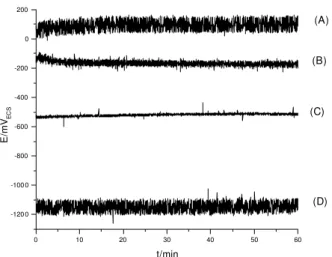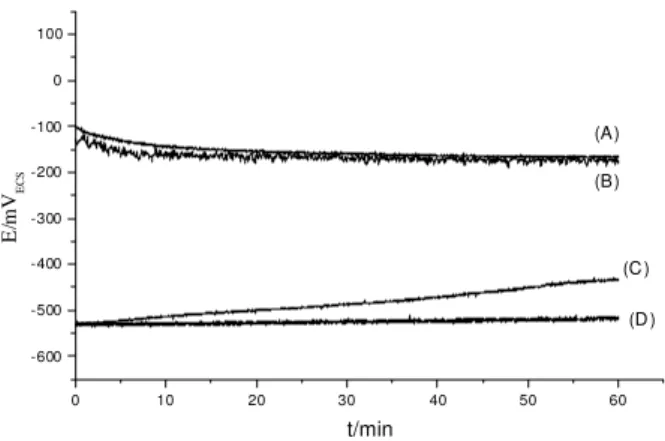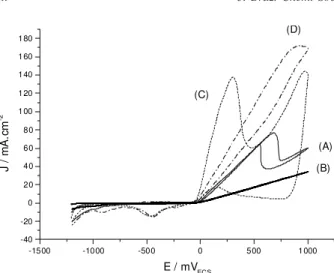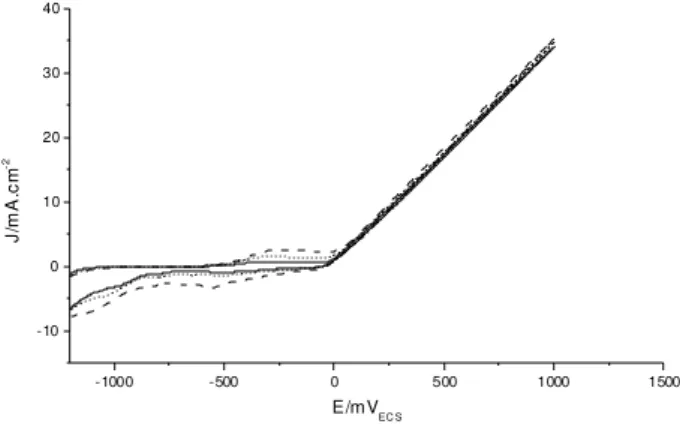Article
Electrodissolution of Cu-Zn Alloys in Acetate Media
Vinicius C. Machado, Annelise M. Schmidt and Denise S. Azambuja*
Instituto de Química, Universidade Federal do Rio Grande do Sul, Av. Bento Gonçalves, 9500, CP 15003, 91501-970, Porto Alegre - RS, Brazil
A eletrodissolução de ligas de Cu-Zn, de diferentes composição química (CuZn37 e CuZn39Pb3) foi estudada em solução tampão de acetato, pH 5, através de medidas de potencial de circuito aberto e voltametria cíclica, sob condições estáticas e dinâmicas. A menor resistência à corrosão detectada nestas ligas, comparativamente ao Cu puro, foi atribuída à estrutura da camada anódica formada ZnO.x H 2O /Cu2O-CuO, a qual apresenta menor proteção que a camada Cu2O-CuO, formada
sobre o eletrodo de Cu puro. Não foi observada a dissolução seletiva do Zn, verificando-se a dissolução simultânea dos constituintes das ligas. A velocidade de eletrodissolução das ligas neste meio, mostrou-se superior à do Cu puro e inferior à do Zn puro .
The eletrodissolution of Cu-Zn alloys with different chemical compositions (Cu37Zn and Cu39Zn3Pb) in acetate buffer pH 5 was studied by means of corrosion potential measurements and cyclic voltammetry, under static and dynamic conditions. The lower corrosion resistance of the brass in comparison to pure Cu, was attributed to the anodic layer structure consisting of a complex ZnO.x H2O /Cu2O-CuO layer, which is less protective than the Cu2O-CuO passive layer produced onto
Cu. No selective dissolution of Zn was detected at both alloys, being their electrodissolution rate higher than that of pure Cu and smaller than that of pure Zn.
Keywords: brass, dezincification, acetate media
Printed in Brazil 0103 - 5053 $6.00+0.00
Introduction
The electrochemical behaviour of Cu-Zn alloys in dif-ferent environments has been extensively studied over a wide range of experimental conditions1-3. It depends on
the alloy composition, the distribution of Cu and Zn oxides and their atomic species at the alloy surface, solu-tion composisolu-tion, surface pre-treatment and temperature. The study of the corrosion and passivation of these alloys (named brass) has been particularly oriented towards dezincification and stress corrosion cracking of this mate-rial. Dezincification is a well-known dealloying process by which the preferential dissolution of the Zn component takes place leaving a porous residue rich in Cu. Conversely, the brass loses its valuable physical and mechanical prop-erties, leading to structural failure. The dezincification of
α-, β-, and (α+β)-brass was studied comparatively in sulphuric acid solution. The obtained data indicate that the corrosion of α-brass is remarkable and resulted in the
depletion of Cu, whereas the (α+β)-brass revealed galvanic dezincification3. In alkaline media Morales et al.4 found
that the corrosion resistance increases in the following or-der (α+β)-brass ≅β-brass < α-brass.
The exact mechanism of the Zn selective dissolution is not completely understood, however there was reasonable correlation between the effect of the brass crystallographic structure and the dezincification. In this connection, the addition of an alloying element such as Sb, Al or Pb has been proposed to increase the brass corrosion resistance. In the case of leaded brass, the presence of Pb improves the machinability of the brass5.
Although much work has been devoted on this sub-ject, very little information have been reported concern-ing the brass dissolution mechanism in nearly neutral aqueous solutions containing acetate anion. A general sur-vey on the literature indicates that despite the scarce data available on this subject, the acetate presence enhances the corrosion rate of copper6,7 and also that stress
corro-sion cracking and generalised corrocorro-sion can be induced in α-brass by sodium acetate8.
The present work is devoted to the investigation of the
electrochemical behaviour of two (α+β)-brasses, with
different chemical compositions (Cu37Zn and Cu39Zn3Pb) in aqueous sodium acetate (Ac) buffer pH 5, by means of corrosion potential measurements and cyclic voltammetry, under static and dynamic conditions. The effect of Pb on the corrosion rate of the brass was studied.
Experimental
Measurements were made on Cu (99.999% purity), Zn (99.999% purity) Cu37Zn and Cu39Zn3Pb rotating disc elec-trodes axially embedded in a Teflon holder to offer a flat disc shaped surface of 0.0314 cm2 geometric area, which could be
used either still or under rotation. The pure metals are from Aldrich and the brasses from Goodfellow. The electrodes were polished with 600, 1200 and 2400 grit water-papers, degreased with etanol p.a. and rinsed with twice-distilled water.
A saturated calomel electrode (SCE) provided with a Luggin capillary tip, was used as reference electrode and all potentials were referred to this electrode. A large platinum wire was used as counter-electrode, inserted in a glass tube ended by a filter glass. The three-electrodes were mounted in a conventional glass cell. Experiments were carried out with sodium acetate aqueous solutions (0.1 and 1 mol L-1
Ac) and the pH was adjusted to 5 using glacial acetic acid. Electrolytes were prepared from analytical grade reagents and twice-distilled water. All solutions were deaerated by bubbling with N2 for 10 minutes prior to any measurement and were purged continuously throughout the experiment. The temperature was maintained at 298K.
Voltammetric measurements were made by using a Bipotentiostat EG&G PAR model 366 and an analytical rotator EG&G PAR model 616.
Results and Discussion
Figure 1 shows the variation of the open–circuit potential (Ecorr) with time, over a period of 60 minutes, for the different alloys, Cu and Zn electrodes in 0.1 mol L-1 Ac buffer pH 5,
under static conditions. The Ecorr for Cu electrode remains in the metal active zone, where Cu (I) is stable9. Concerning the
Zn electrode the Ecorr remains also in the active zone of this metal9. The open-circuit potential value for Cu37Zn alloy is
more negative than that of pure Cu. There is a linear Ecorr/time relation rise with a slightly negative slope, which reaches a steady state value after 10 minutes. In the case of Cu39Zn3Pb the open–circuit potential corresponds to thermodynamic potential range where Pb (II) is stable, meaning that the preferential dissolution of Pb takes place9.The presence of Pb
as a separate phase in the (α+β)-brass microstructure explains the close relation between these values. Similar results were reported for leaded brass in a phosphate buffer, pH 75.
Potential oscillations were detected during the measure-ments for all working electrodes. According to thermody-namic data, the open-circuit potential value for each speci-men corresponds to the metal active zone. So, this feature can be attributed to a dissolution/precipitation process tak-ing place at the electrode surface, as soon as it was im-mersed in the acetate solution. These findings are in agree-ment with what has been obtained for Cu-based alloys in alkaline media by Hurtado et al10. Observations of poten-tial transient fluctuations under galvanostatic control and open circuit conditions, or of current transient fluctuations under potentiostatic control is a well-documented feature of the metal corrosion11. Oscillations observed from the
oxidation of metals are directly linked to specific condi-tions of potential, hydrodynamics and electrolyte compo-sition. Keiser and Cherson12 have detected voltage
oscilla-tions for Fe in H2SO4.They proposed a theory which in-volves the coupling between the electric field and redu-cible species diffusion near the electrode surface and in-cludes certain effects of double layer relaxation. On the other hand, theoretical treatments point out that the oscilla-tory nature of the potential transients can be related to the coexistence of a multiplicity of steady states13.
Open–circuit potential shifting to more negative
val-ues is observed for Cu7 in 1M Ac solution and to more
positive values for Cu39Zn3Pb. The leaded brass reaches a steady-state potential of –0.49V after 50 minutes of im-mersion. On increasing acetate concentration, the Zn and Cu37Zn corrosion potential values remain unaltered (not shown here). This means that at the open-circuit potential these specimens reach a pseudo steady-state, independent of the acetate concentration14. Based upon these data (Figure 1)
it can be concluded that at the open–circuit potential, the selective dissolution of Zn, at both brasses, was not
Figure 1. Variation of the corrosion potential (Ecorr) with immer-sion time in 0.1mol L-1 Ac solution, pH 5 at: ω = 0 rpm, for Cu (A), Zn(B), Cu37Zn (C) and CU39Zn3Pb (D) disc electrodes.
0 10 20 30 40 50 60
-120 0 -100 0 -800 -600 -400 -200 0 200
(D) (C)
(B) (A)
E/m
VEC
S
observed, whereas the simultaneous dissolution of the al-loy components takes place.
For the Cu electrode, data obtained in previous work7
showed that the Ecorr shifts to more negative values under electrode rotation. Thus, on increasing the mass transport rate, the Cu (I) species flux into the solution increases exposing the bare metal to further dissolution shifting Ecorr to more negative values. Feng et al.15 reported a similar
Ecorr dependence with rotation speed for copper in sul-phate solutions at pH 5. Their results have been explained by assuming that still solutions favour the deposition of Cu (I) species at the metal-solution interface due to the Cu2O low solubility. Electrode rotation has no effect on the open-circuit potential of Zn electrode (data not shown). In order to investigate the effect of electrode rotation on the open–circuit potential, experiments were carried out at 500 rpm (Figure 2). In the case of the Cu37Zn brass, electrode rotation produces no changes on the Ecorr value, however the oscillatory behaviour enhances. So, at the open circuit potential, for Cu37Zn and Zn electrodes, the process is independent of mass transport, being limited by an electrochemical step14 (charge transfer, adsorption,
sur-face chemical reaction, etc.). A distinct behaviour was detected at the Cu39Zn3Pb specimen : on increasing the mass transport rate, the Ecorr shifts to more positive values. These features seem to indicate that a topochemical pro-cess takes place at the leaded brass surface16, being
de-pendent on electrode rotation. The Ecorr/time profiles show that the oscillations enhanced under dynamic conditions. These features were previously observed for Cu rotating disc electrode in chloride17 and in acetate media18 under
potentiodynamic conditions. According to reference 18 once the oscillations began, they could be stopped (and restarted) by adjusting the potential and/or the rotation rate. There is an agreement in the literature that specific conditions including the metal surface morphology, film thickness, composition and structure, are generally asso-ciated with the existence and structure of a particular type of oscillatory behaviour The dezincification produces a porous layer onto the brass surface, enhancing the electro-chemical oscillations19.
The effect of acetate concentration on the copper cyclic voltammograms run from Esc = -1.0 V to Esa = 1.0 V, at 0.001 V s-1 sweep rate, with stationary electrode in 0.1 mol L-1 Ac
(solid line) and 1 mol L-1 Ac (dashed line) solutions is
shown in Figure 3. The anodic scan in 0.1 mol L-1 Ac
exhibits three peaks A1, A2 and A3 followed by a sharp
current decrease until a minimum value (0.2 mA cm-2)
around 0.5 V. This potential was assigned as the Flade poten-tial (EF) similarly to what has been previously reported20.
In the reverse direction of the scan a reactivation of the
electrooxidation process is observed at the same potentials of the forward scan, followed by a small cathodic peak C1 located at - 0.2 V. This behaviour was also described by Drogowska et al.21 for copper in bicarbonate solution
in-dicating that the metal is highly soluble despite the fact that the electrode surface remains covered by a film. On increasing acetate concentration (dashed line) the poten-tial of the anodic peaks and also the EF shifts toward more negative values indicating that the dissolution/precipita-tion processes are anticipated. At more concentrated acetate solutions a sharp current increase is observed at the rising portion of peak A1 suggesting that the film becomes less protective. According thermodynamic data9 these anodic
processes can be ascribed to a first oxidation process from Cu (0) to Cu (I) followed by a second stage yielding Cu (II) as already reported in the literature22.
0 10 20 30 40 50 60
-600 -500 -400 -300 -200 -100 0 100
(D ) (C ) (B) (A)
E/
m
VEC
S
t/min
Figure 2. Variation of the corrosion potential (Ecorr) for the alloys electrodes with immersion time in 0.1 mol L-1 Ac solution, pH 5 under electrode rotation: (A) Cu37Zn at ω = 0 rpm (B) Cu37Zn at, at ω = 500 rpm, (C) Cu39Zn3Pb at ω = 0 rpm and (D) Cu39Zn3Pb at ω = 500 rpm.
Figure 3. Influence of acetate concentration on voltammograms obtained with a Cu disc electrode, between Esc= - 1.0.V and Esa= 1.0 V
at 0.001 V s-1, under static conditions: () 0.1 mol L-1 Ac solution,
(---) 1 mol L-1 Ac solution.
The voltammogram obtained with a Zn electrode un-der static conditions (Figure 4) in 0.1 mol L-1 Ac shows an
abrupt current increase when the potential is shifted posi-tively. The reverse potential scan presents a small cathodic peak at -0.8V, which can be assigned to the electroreduction
In 1 mol L-1 Ac the anodic scan exhibits an intense
disso-lution process and no cathodic peak was detected at the reverse scan (data not shown).
1 Ac) the corrosion rate for both alloys decreases abruptly,
even for the leaded brass. So, the corrosion resistance of the Cu-Zn alloys studied was lower than that of pure Cu, but considerably greater than that of pure Zn. It must be emphasised that the leaded brass presents a higher per-centage of more active components in the alloy (≅42%) if compared with the Cu-37Zn brass.
Therefore the voltammograms run in still solutions, keeping constant the switching potentials, change with acetate concentration. The anodic to cathodic voltammet-ric charge ratio is higher than 1 for all acetate concentra-tions. Electrode rotation produces no changes on the brass voltammograms (data not shown).
Previous work on the electrodissolution of copper in acetate media concluded that the mechanism involves a sequence of competitive and parallel reactions giving rise to a duplex film on the metal surface, whose nature and composition are dependent on the acetate concentration and time of polarisation7,18.
To gain further information about the electrodissolution of these alloys the effect of the sweep rate on the electrodissolution was analysed. The sweep rate (ν) effect
on Cu37Zn voltammograms in 0.1 mol L-1 Ac solution
obtained under static conditions, run from Esc = -1.2 V to Esa = 1.0 V, is shown in Figure 6. The anodic to cathodic charge ratio is practically ν-independent, being higher than unity, in the entire range of ν employed in this study. So, it can be concluded that the anodic process is mainly alloy dissolution and only a fraction of the anodic layer can be electroreduced. This behaviour was also observed with less concentrated acetate solution. The anodic layer resis-tance is not influenced by the polarisation time, similarly to what happens with pure Zn in this media.
Figure 4. Voltammogram obtained with a Zn disc electrode in 0.1 mol L-1 Ac solution, between E
sc= - 1.0.V and Esa= 1.0 V at
0.001 V s-1 and under static conditions.
Figure 5 shows the effect of acetate concentration on the cyclic voltammograms for both alloys, run from Esc = -1.2 V to Esa = 1.0 V, at 0.001 V s-1 sweep rate, under static conditions. On increasing the acetate concentration the alloys dissolution rate increases. For Cu37Zn in 0.1 mol L-1 Ac the anodic scan exhibits a peak at ca 0.6V
which can be related to the formation of cupric species. The potential scan in the negative direction presents an intense reactivation process followed by a cathodicpeak at -1.0V. The shape of the Cu37Zn voltammetric curve changes in 1 mol L-1 Ac solution, indicating that a less resistive film was formed. The anodic peak is anticipated, similarly what has been observed with pure Cu (see Figure 3). The cathodic scan shows the presence of a reactivation process, followed by a cathodic peak at –0.5V that can be related to the electroreduction of copper. The anodic to cathodic charge ratio is always greater than the unity re-vealing that the alloy dissolution is the main process.
The Cu39Zn3Pb voltammograms exhibit an intense dissolution process. No film formation was detected in 0.1mol L-1 Ac. On increasing acetate concentration an hysteresis is observed at more positive potentials. The nega-tive going scan presents three cathodic peaks located at -0.25V, -0.48V and -0.90V, respectively. The electroreduc-tion processes involving cuprous and cupric species origi-nate the peaks at -0.25V and -0.48V. The peak at -0.90V is assigned to the Zn electroreduction and the HER4. These voltammograms indicate that the structure and/or compo-sition of the anodic layer is dependent on the acetate con-centration. The most remarkable feature is that at similar experimental conditions, the dissolution rate at the leaded brass in 0.1 mol L-1 Ac is smaller than that observed at the
Cu37Zn. However, in more concentrated solution (1 mol L
--1500 -1000 -500 0 500 1000
-40 -20 0 20 40 60 80 100 120 140 160
180 (D)
(C)
(B) (A)
J /
m
A
.c
m
-2
E / mVECS
Figure 5. Influence of acetate concentration on voltammograms ob-tained with the alloys disc electrodes, between Esc= - 1.0.V and Esa= 1.0 V at 0.001 V s-1, under static conditions: (A)Cu37Zn in 0.1 mol L-1 Ac solution, (B)Cu37Zn in 1 mol L-1 Ac solution, (C) Cu39Zn3Pb in
Figure 7 points out the effect of ν on the Cu39Zn3Pb-brass voltammograms. The broad and asymmetric anodic peak observed around -0.30V, during the positive going scan enhances as ν increased, whereas the anodic to ca-thodic current crossover potential becomes ν-independent. These features seem to indicate that the anodic thickening layer is determined by the diffusion of reactants through the growing film. Again, these findings are an indication that a change in the structure and /or composition of the anodic layer takes place on changing the time of polarisa-tion, similarly what was described for pure Cu7. Moreover
the Pb dissolution is favoured when high sweep rates (ν > 0.050V s–1) are employed22. So, under this
condi-tion, the dissolution/precipitation of Pb+2 on the electrode
surface can seal uncovered active sites and improve the anodic layer resistance.
structure consisting of a complex ZnO.x H2O /Cu2O-CuO layer, which is less protective than the Cu2O-CuO passive layer produced onto Cu. A comparison between the alloys and pure Cu voltammetric curves, point in relief that the anodic layers formed on brass, are porous and under diffu-sion controll23.
The structure of the anodic layer formed onto Cu elec-trode in acetate was previously studied using RRDE ex-periments24. The obtained results point out that the
fara-daic process occurring at the Cu disc involves the forma-tion of both insoluble and soluble Cu (I) and Cu(II) spe-cies. The small current due to Cu (II) at the ring could indicate that these species are complexed by adsorbed acetate at the disc surface. Further, tabulated data show that the cupric acetate has a low solubility in water6 which
reinforces the idea of the copper complex formation. Ac-cording to Stulikova et al.25 the voltammetric curves of Cu (II) in acetate media at a glassy carbon electrode seem to depend on a great extent on the degree to which monova-lent copper, produced in an electrochemical reaction, re-mains adsorbed on the electrode surface to undergo fur-ther electrochemical reactions. Probably the adsorption/ desorption equilibrium of the intermediate Cu (I) in cop-per dissolution is altered by the presence of adsorbed acetate on the metal surface. This assumption is consistent what has been reported in various investigations26,27.
Based upon the voltametric experiments and in analo-gy with the data reported for Cu electrode it is possible to postulate the participation of the acetate anion in the film formation process. It follows from the brass cyclic voltammograms that the alloys mechanism dissolution is dependent on the applied potential : at low anodic overpotential the preferential dissolution takes place, be-ing the simultaneous dissolution dominant at higher ano-dic overpotential .
Conclusion
From the open-circuit measurements and the voltam-metric data it was possible to characterise the distinct behaviour of the Cu37Zn and Cu39Zn3Pb alloy. The open-circuit potential of these alloys occurs at potentials more negatives than that of pure Cu and markedly more posi-tive than that of Zn. The open-circuit potential is indepen-dent on acetate concentration for both alloys, whereas the electrode rotation shifts the Cu39Zn3Pb potential to more noble values.
From the voltammetric data it is proposed that the an-odic layer formed at more positive potentials, consists of ZnO.x H 2O/Cu2O-CuO, which is influenced by acetate concentration. Under the experimental conditions used in
-1000 -500 0 500 1000
-20 0 20 40 60 80 100
J/
mA.
cm
-2
E/mVEC S
Figure 6. Influence of the sweep rate (ν) on voltammograms obtained with a Cu37Zn disc electrode in 0.1 mol L-1 Ac solution, between
Esc= - 1.0.V and Esa= 1.0 V at ν = 0.01 V s-1 (), ν = 0.02 V s-1 (....), ν = 0.05 V s-1 (---).
-1000 -500 0 500 1000 1500
-10 0 10 20 30 40
J/
mA.
cm
-2
E/mVEC S
Figure 7. Influence of the sweep rate (ν) on voltammograms obtained with a Cu39Zn3Pb disc electrode in 0.1 mol L-1 Ac solution, between Esc= - 1.0.V and Esa= 1.0 V at ν = 0.01 V s-1 (), ν = 0.02 V s-1 (....), ν = 0.05 V s-1 (---).
this work no selective dissolution of Zn was detected at both alloys, being their electrodissolution rate higher than that of pure Cu and smaller than that of pure Zn. The preferential dissolution of Zn was detected, although the simultaneous dissolution of the brass components takes place at both al-loys, in accordance with their chemical composition.
Acknowledgements
Financial support by FAPERGS, CAPES and CNPq is gratefully acknowledged.
References
1. Langenegger, E. E.; Calladhan, B. G. Corrosion, 1972,
28, 245.
2. Lee, C. K.; Shih, H. Corrosion 1996, 52, 141. 3. El-Egamy, S. S.; El-Azab, A. S.; Badawy, W. A.
Corro-sion 1994, 50, 468.
4. Morales, J.; Fernadez, G. T. ; Esparza, P.; Gonzalez, S.; Salvarezza, R. C.; Arvia, A. J. Corros. Sci. 1995,
37, 211.
5. Al-Kharafi, F. M.; Badawy, W. A. Mater. Sci. Forum
1998, 289, 471.
6. Dewald, H. D.; Parman, P.; Rollins, R. W. J. Electroanal. Chem.1991, 306, 297 .
7. Schmidt, A. M. Thesis, Universidade Federal do Rio Grande do Sul, 1997.
8. Parkins, R. N.; Holroyd, N. J. H. Corrosion1982,
38, 245.
9. Pourbaix, M. Atlas of Electrochemical Equilibria in Aqueous Solutions, NACE, Houston, 1974.
10. Hurtado, M. R. F.; Sumodjo, P. T. A.; Benedetti, A .V.
J. Electochem. Soc.1993, 140, 1567.
11. Burnstein, G. T.; Pistorius, P. C.; Mattin, S. P. Corros.
Sci.1987, 57, 289.
12. Keizer, J.; Scherson, D. J. Phys. Chem. 1980, 84, 2025. 13. Sharland, S. M. Corros. Sci.1987, 27, 289.
14. Power, G. P.; Ritchie, I. M. Electrochim. Acta, 1981,
26, 1073.
15. Feng, Y.; Siow, K. S.; Teo, W. K.; Hsieh, A. K.
Corro-sion1997, 53, 389.
16. Gileadi, E.; Kirowa-Eisner, E.; Penciner, J. Interfa-cial Electrochemistry. AnExperimental Approach,
Addison-Wesley Publis. Comp., Inc., Massachu-setts, 1975.
17. Lee, H. P.; Nobe, K.; Pearlstein, A. J. J.Electrochem.
Soc.1985, 132, 1031.
18. Dewald, H. D.; Parmananda, P.; Rollins, R. W.
J. Electrochem. Soc. 1993, 140, 1969.
19. Badawy, W. A.; Al-Kharafi, F. M. Corrosion1999,
55, 268.
20. Mostafa, S. N.; Mourad, M. Y.; Seliman, S. A.
J. Electroanal. Chem.1981, 130, 221.
21. Drogowska, M.; Brossard, L.; Ménard, H. J. Appl. Electrochem.1994, 24, 344 .
22. Kremer, E.; Azambuja, D. S. J. Braz. Chem. Soc. 1997,
8, 165.
23. Calandra, A. J.; Taconi, N. R.; Pereiro, R.; Arvia, A. J.;
Electrochim. Acta 1974, 19, 901.
24. Schmidt, A. M.; Azambuja, D. S. Corros.Sci. ‘’submit-ted for publication”.
25. Stulikovà, M.; Vydra, F. J. Electroanal. Chem., 1973,
44, 117.
26. Sander, U.; Strehblow, H. -H; Dohrmann, J. K.
J. Phys. Chem.1981, 85, 447.
27. Coulter, P. D.; Iwamoto, R. T. J. Electroanal. Chem.,
1967, 13, 21.



